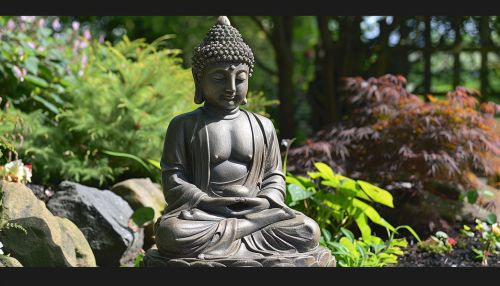Tathagatagarbha
Tathagatagarbha
Tathagatagarbha, often translated as "Buddha-nature," is a central concept in Mahayana Buddhism. It refers to the intrinsic potential for enlightenment that exists within all sentient beings. This concept asserts that all beings possess an inherent nature that is fundamentally pure and enlightened, even if it is obscured by ignorance and delusion. The term "Tathagatagarbha" is derived from two Sanskrit words: "Tathagata," meaning "thus gone" or "thus come," a title for the Buddha, and "garbha," meaning "womb" or "embryo." Thus, Tathagatagarbha can be understood as the "womb of the Tathagata" or the "embryo of Buddhahood."


Historical Development
The concept of Tathagatagarbha emerged in the early centuries of the Common Era, particularly within the Mahayana tradition. It is closely associated with several key Mahayana sutras, including the Tathagatagarbha Sutra, the Srimala Sutra, and the Lankavatara Sutra. These texts emphasize the inherent potential for enlightenment within all beings and often use metaphors such as a hidden treasure or a seed to illustrate this potential.
The Tathagatagarbha doctrine was further developed by influential Buddhist philosophers such as Asanga and Vasubandhu, who integrated it into the broader framework of Yogacara philosophy. In the 5th century, the Ratnagotravibhaga (also known as the Uttaratantra Shastra) provided a systematic exposition of the Tathagatagarbha theory, elaborating on its implications for the nature of mind and the path to enlightenment.
Philosophical Implications
The Tathagatagarbha doctrine has profound philosophical implications for the understanding of the nature of mind and the process of enlightenment. It posits that the mind's true nature is inherently pure and luminous, but it is obscured by adventitious defilements. This view contrasts with other Buddhist teachings that emphasize the mind's emptiness (shunyata) and the absence of inherent existence.
The Tathagatagarbha concept reconciles the apparent contradiction between the mind's inherent purity and its defiled state by asserting that the defilements are temporary and can be removed through the practice of the Bodhisattva path. This perspective provides a positive and hopeful view of the potential for enlightenment, emphasizing that all beings have the capacity to achieve Buddhahood.
Tathagatagarbha and Other Buddhist Doctrines
The Tathagatagarbha doctrine is often compared and contrasted with other key Buddhist teachings, such as the Madhyamaka philosophy of Nagarjuna and the Yogacara school's emphasis on the nature of consciousness. While Madhyamaka focuses on the emptiness of all phenomena, including the mind, Tathagatagarbha emphasizes the mind's inherent purity and potential for enlightenment. Yogacara, on the other hand, explores the nature of consciousness and the process of perception, providing a complementary perspective to the Tathagatagarbha doctrine.
Despite these differences, the Tathagatagarbha concept is not seen as contradictory to the teachings of emptiness. Instead, it is understood as a skillful means (upaya) to inspire practitioners and encourage them on the path to enlightenment. By emphasizing the positive potential within all beings, the Tathagatagarbha doctrine provides a powerful motivation for practice and a profound sense of hope and possibility.
Tathagatagarbha in East Asian Buddhism
The Tathagatagarbha doctrine has had a significant impact on the development of East Asian Buddhism, particularly in China, Korea, and Japan. In China, the concept was integrated into the teachings of the Tiantai and Huayan schools, which emphasized the interpenetration of all phenomena and the inherent potential for enlightenment within all beings. The Tathagatagarbha doctrine also influenced the development of Chan (Zen) Buddhism, which emphasizes the direct realization of one's true nature.
In Japan, the Tathagatagarbha concept played a crucial role in the development of Shingon and Tendai Buddhism. Shingon, founded by the monk Kukai, incorporates Tathagatagarbha teachings into its esoteric practices, emphasizing the realization of one's inherent Buddhahood through ritual and meditation. Tendai, founded by Saicho, also integrates Tathagatagarbha teachings, particularly in its emphasis on the inherent potential for enlightenment within all beings.
Criticisms and Controversies
The Tathagatagarbha doctrine has not been without its critics. Some Buddhist scholars and practitioners have raised concerns that the concept of an inherent Buddha-nature could be interpreted as implying a permanent, unchanging self (atman), which would be contrary to the fundamental Buddhist teaching of anatman (non-self). To address these concerns, proponents of the Tathagatagarbha doctrine have emphasized that the Buddha-nature is not a self but rather a potential for enlightenment that is empty of inherent existence.
Another criticism of the Tathagatagarbha doctrine is that it could lead to complacency among practitioners, who might believe that their inherent Buddha-nature guarantees their eventual enlightenment without the need for diligent practice. In response, teachers of the Tathagatagarbha doctrine have stressed the importance of practice and the removal of defilements to realize one's inherent potential.
Modern Interpretations and Applications
In contemporary Buddhism, the Tathagatagarbha doctrine continues to be a source of inspiration and debate. Modern Buddhist teachers and scholars have explored the implications of the Tathagatagarbha concept for understanding the nature of mind and the process of spiritual development. Some have drawn parallels between the Tathagatagarbha doctrine and modern psychological theories, suggesting that the concept of an inherent potential for enlightenment can be understood in terms of human psychological growth and transformation.
In addition, the Tathagatagarbha doctrine has been applied in various modern contexts, including psychotherapy and social activism. Some contemporary Buddhist practitioners have used the concept of Buddha-nature to promote a sense of inherent worth and dignity in individuals, as well as to inspire efforts toward social justice and environmental sustainability.
Conclusion
The Tathagatagarbha doctrine is a profound and complex concept that has played a significant role in the development of Mahayana Buddhism. By emphasizing the inherent potential for enlightenment within all beings, the Tathagatagarbha doctrine provides a positive and hopeful vision of the path to Buddhahood. Despite its controversies and criticisms, the concept of Buddha-nature continues to inspire and challenge Buddhist practitioners and scholars, offering a rich and multifaceted perspective on the nature of mind and the process of spiritual awakening.
